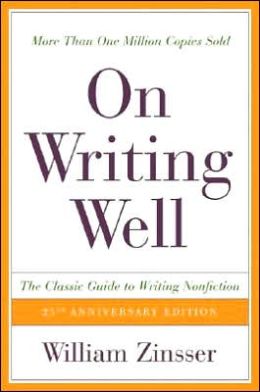A True Well of Knowledge
When I first picked up On Writing Well by William
Zinsser, I thought it was about writing wells – metaphorical wells that
delineated the depth of writing. Although I quickly realized that this
guide to writing nonfiction actually focused on distinguishing well-written
pieces of writing, analyzing the aspects of well-written writing, and
describing how to write well, I discovered that my initial thought was
interwoven between the book’s pages.
Slowly, I learned that the book was a well of knowledge itself.
On Writing Well is split into four distinct parts:
the principles, the methods, the forms, and the attitudes. I thought that making separate parts was a
practical idea because readers are first exposed to the content that makes up each
section and can make connections between each section afterwards. These four parts are further divided into
twenty-four chapters, each covering a subtopic of nonfiction writing, including
“Simplicity,” “Nonfiction as Literature,” and “A Writer’s Decisions.” One thing I enjoyed about the book’s
structure was that the chapters weren’t too long. Although most of the chapters were less than
ten pages each, they were all extensive in their content. Zinsser compressed his knowledge about
varying topics into concise yet clear chapters.
He adeptly provided detailed descriptions of ideas he wanted to convey
without continuously rambling on a subject.
By keeping his chapters short, readers are less likely to lose their
attention and get distracted. I was able
to take away a significant amount of his knowledge from the succinct chapters,
as well as a large number of writing tips I can apply to my writing in the
future.
Another standout quality of this nonfiction writing guide is
Zinsser’s voice, which can be heard throughout every paragraph of every
chapter. Zinsser is a well-seasoned
writer: he has written for over five magazines and has written over ten
books. Zinsser’s website, William Zinsser, states that he has also
had experience being a feature writer, drama editor, film critic, and editorial
writer. In addition, he taught
nonfiction and humor fiction at Yale University and was a knowledgeable lyricist.
Even though Zinsser has a myriad of achievements scattered
throughout his writing career, his voice comes through as being genuine and
honest – most of the time. There are
several instances where he sounds condescending or conceited, however. For example, he comments that the concept
“readers read with their eyes” (Zinsser On
Writing Well 36) may seem absurd to us, as readers of his book. By explicitly telling us that people use
their eyes to read, he creates a sense that we are inferior to him for not
recognizing an undeniable observation. Later
in the book, he makes a sweeping, general statement that his readers enjoy his
arrangement of words, as well as the effort he makes to entertain them. With the exception of these parts that might
be perceived as a little pretentious, Zinsser discusses nonfiction writing very
clearly throughout the guide. For
example, he minimizes the ideas he is trying to explain to concise sentences,
and he also devotes chapters, such as “Simplicity” and “Clutter,” to discussing
succinct writing. Furthermore, he uses
relatable analogies to get his ideas across.
Zinsser points out that “fighting clutter is like fighting weeds” (Zinsser
On Writing Well 13) and that “memoir
is a window into a life” (Zinsser On
Writing Well 136). These interesting
comparisons simultaneously allow readers to make connections to the larger world
and foster deeper analysis of nonfiction writing among a broader community of
writers.
In addition to his own commentary on certain topics, such as words
and usage, Zinsser provides a multitude of writing samples from many
authors. These examples give Zinsser’s
ideas substance, providing tangible excerpts rather than paragraphs explaining
abstract concepts. By including a
multitude of writers in his nonfiction guide, Zinsser provides readers with
different approaches to the many techniques of writing nonfiction he describes. Readers are also exposed to various styles of
nonfiction writing and a wide range of topics on which nonfiction writers
write. Although I liked that he
incorporated different authors and numerous pieces of writing throughout the
book, it seemed that some chapters, such as “Science and Technology,” had too
many example passages. After reading
several pages of sample after sample, the ideas blurred together and became
redundant.
Despite a few shortcomings, Zinsser’s nonfiction writing guide is
well-structured and well-written. It’s
organized in a clear and pragmatic manner.
The brief chapters hold readers’ attention while offering an abundance
of experiences, information, and advice.
Because it contains such a wide range of knowledge, I think writers at
any level can benefit from reading this book.
If On Writing Well were an
actual well, it would be overflowing. It
would be one with a constant supply of substantial writing instruction.
Works Cited
Zinsser,
William K. On Writing Well. 25th ed. New York: HarperCollins, 2001.
Print.
Zinsser, William K. "William Knowlton
Zinsser." William Zinsser.
N.p., 2010. Web. 21 Nov. 2013.

No comments:
Post a Comment